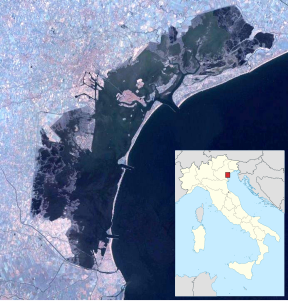Carbonera (island)
| Carbonera | ||
|---|---|---|
| Waters | Venice lagoon | |
| Geographical location | 45 ° 28 '51.3 " N , 12 ° 21' 7.8" E | |
|
|
||
| surface | 0.586 7 ha | |
| Residents | uninhabited | |
Carbonera , formerly Batteria Carbonera , is a small island in the Venice Lagoon , which is northwest of Murano . The island on the upper reaches of the Canale Carbonera, which flows towards Murano, has an area of 5,867 m² and was mainly used for military purposes. It is located in an area of the lagoon that has a significantly lower proportion of salt in the water. While the average value in the lagoon is 2.8-3.4%, around Carbonera this value falls to 2.1%. This is due to the fact that the island is near the confluence of the Osellino, which brings fresh water into the lagoon; the biodiversity is comparatively low.
history
In the vicinity of the island, reed bed settled beneath a layer of sandstone to the time around 12,860 BC. To date to BC; this was found about 1.50 m below today's average water level. The remains of a paleo-Venetian necropolis from the 6th century BC were found beneath today's runway at the nearby Marco Polo Airport . BC Carbonera was inundated by the lagoon water in late Roman times, as a probe in the 1970s revealed. In fact, about 30 m south of today's southern edge of the island, about 1.30 m below the water level, bricks and amphora fragments from the 1st to 4th centuries can be detected. To the east of it, Roman pottery came to light.
The island, formerly known as Batteria Carbonera, was part of the defense system of the Republic of Venice , like many of the Venetian islands . This system comprised eight related island fortresses between Venice and Mestre , namely Fisolo , Campana , Ex Poveglia and Trezze in the south of the lagoon, in the middle and in the north these were the islands of Campalto , Tessera and Buel del Lovo in addition to Carbonera . In 1796, all fortresses except Trezze were in place, but still mostly made of wood.
Carbonera became the seat of a radio and telegraph station for the Italian Navy in the 20th century, some of which can still be seen today.
In the 1960s the island was rebuilt for residential purposes, but it was uninhabited at the end of the 20th century.
Web links
- Batteria Carbonera, website of the Comune di Venezia ( memento of September 19, 2009 in the Internet Archive ), September 19, 2009
- Isola di Carbonera, laguna veneta: abbandonata dopo gli anni '60 , photograph in the article C'è ancora vita in quei borghi dimenticati of the Republic of October 1, 2016
Remarks
- ↑ Venice Islands ( memento of March 24, 2009 in the Internet Archive ), archive.org, March 24, 2009.
- ^ Daniele Curiel, Mario Scattolin, Silvia Gentilin, Mara Marzocchi: Le macroalghe dei substrati duri delle isole della laguna di Venezia , in: Società Veneziana di Scienze Naturali 29 (2004) 47–57, here: p. 47.
- ^ Ernesto Canal : Archeologia della Laguna di Venezia , Cierre, 2015, p. 238, sito 101.3.
- ^ Ernesto Canal: Archeologia della Laguna di Venezia , Cierre, 2015, p. 237, sito 98.3.
- ^ Bollettino della Società geologica italiana 96 (1979), p. 268.
- ↑ Ernesto Canal: Archeologia della Laguna di Venezia , Cierre, 2015, p. 238, sito 100.2 and 101.1-2.
